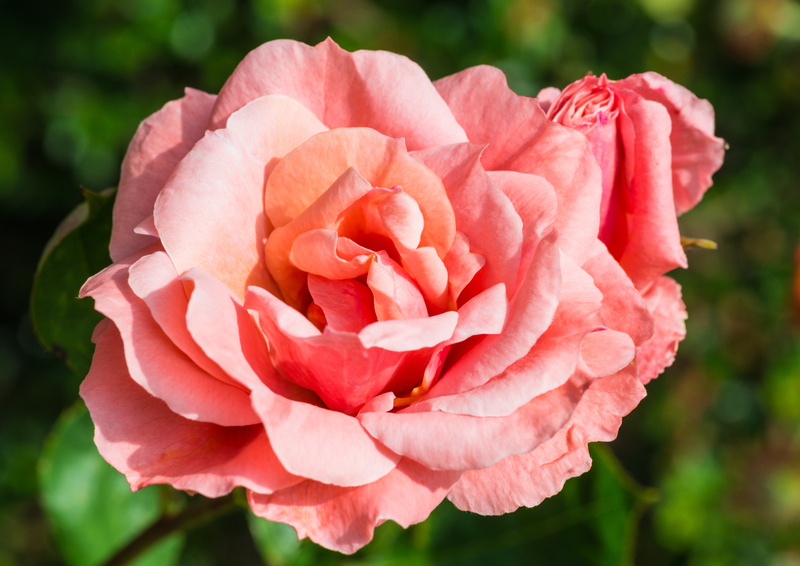Achieve a Weed-Free Garden: Follow These 3 Tips
Posted on 05/06/2025
Achieve a Weed-Free Garden: Follow These 3 Tips
Gardeners everywhere dream of harvesting a lush, vibrant garden that is free from the invasion of pesky weeds. An attractive, weed-free yard is not only beautiful but also healthier for your plants. However, keeping weeds at bay requires consistent effort, the right techniques, and a little patience. In this comprehensive guide, we share the top three tips to achieve a weed-free garden. Read on to discover practical strategies and expert advice to help your garden thrive without the constant nuisance of weeds!
Why Are Weeds a Threat to Your Garden?
Weeds are more than just an unsightly problem in your lawn or vegetable beds. In fact, they are fierce competitors for nutrients, moisture, sunlight, and even space. Allowing weeds to spread in your outdoor area will stunt the growth of your desired plants and can introduce pests and diseases. By keeping your garden weed-free, you are ensuring optimal health for your ornamental and edible plants.
- Nutrient Competition: Weeds absorb vital minerals and nutrients, starving your garden plants.
- Reduced Water Availability: Aggressive weeds often consume a disproportionate amount of water.
- Pest Habitat: Weeds can harbor pests and diseases that hurt your beautiful blooms and crops.
- Sunlight Deprivation: Fast-growing weeds block sunlight, impeding the growth of your chosen plants.
- Messy Appearance: A lawn or flower bed filled with weeds looks chaotic and unappealing.
Eliminating and managing weeds is crucial for any gardener who wants to create a healthy, productive, and aesthetically pleasing outdoor space. To help you in your quest, let's dive into the three most effective tips to achieve a weed-free garden!

Tip 1: Adopt Smart Mulching Techniques
One of the most effective ways to prevent weeds from taking over your garden is by using mulch. Mulching not only suppresses weed growth but also improves soil health, retains moisture, and regulates soil temperature. Let's break down how and why you should make mulching a staple in your gardening routine.
Types of Mulch That Keep Weeds Away
Mulch is available in organic and inorganic forms, each with its own benefits. Organic mulch, such as shredded bark, straw, grass clippings, and compost, decomposes over time and adds nutrients to the soil. Inorganic options, such as landscape fabric, gravel, or black plastic, are highly durable and excellent at blocking sunlight, which inhibits weed germination.
- Organic Mulches:
- Shredded bark or wood chips
- Straw or hay (make sure it's seed-free!)
- Grass clippings (layer thinly to avoid matting)
- Compost and leaf mold
- Inorganic Mulches:
- Black plastic sheeting
- Landscape fabric or weed barrier mat
- Gravel or decorative stones
Mulching Best Practices
Follow these steps to maximize the weed-preventing power of mulch:
- Clear existing weeds: Use a hoe or hand-pull weeds before mulching.
- Lay mulch immediately: Cover bare soil as soon as possible to block new weed seeds from finding a home.
- Apply thickly: Aim for a 2-4 inch layer of organic mulch or 1-2 inch layer for inorganic mulch.
- Keep away from stems: Leave a mulch-free zone around stems and trunks to prevent rot.
- Replenish as needed: Top up your mulch every year to maintain coverage and control weeds.
Tip 2: Consistent and Targeted Weeding
No matter how much mulch you use, a few persistent weeds will always find a way through. The key to a weed-free yard is consistency and precision in weeding. Regular removal of young weeds prevents them from setting seed and becoming unmanageable.
Tools for Effective Weeding
Different weeding tools are suited to various tasks. Choosing the right equipment helps you eradicate weeds efficiently without disturbing your desired plants.
- Hand Weeder: Ideal for small weeds and tight spaces, such as between garden plants.
- Hoe: Perfect for cutting weeds in larger beds and along rows.
- Dandelion Digger: Excellent for removing deep-rooted weeds like tap-rooted dandelions.
- Garden Fork or Trowel: Helps break up dense soil and extract root systems completely.
When and How to Weed for Best Results
Consistent weeding is key: Set aside 10-15 minutes a week during the growing season (spring through fall). Here are some additional pro-tips:
- Weed after rain or watering: Damp soil makes it easier to pull weeds up by the roots.
- Remove the whole root: Many common garden weeds will regrow if even a fragment of the root is left behind.
- Don't compost seed-heads: Weeds that have gone to seed can spread if added to compost. Dispose of them in the trash instead.
- Stay vigilant: Remove weeds while they are young before they flower and set seeds.
Tip for perennial weeds: Deep-rooted perennial weeds, such as bindweed and horsetail, may require several removals to weaken the root system. Persistence pays off.
Preventative Measures to Reduce Weeding
Along with manual weeding, you can adopt these maintenance practices to prevent weed outbreaks:
- Densely plant your beds: Closely spaced flowers or vegetables will shade the soil and leave less opportunity for weeds to grow.
- Use landscape edging: Barrier materials such as metal or plastic strips prevent weed roots and seeds from invading from the lawn.
- Top-dress lawns with compost: Healthy, thick grass crowds out weeds and prevents germination of unwanted seeds.
Tip 3: Use Pre-Emergent Weed Controls
Another powerful approach to achieving a weed-free garden is using a pre-emergent weed control strategy. Pre-emergents create a barrier in the soil that prevents weed seeds from germinating, allowing your intentional plantings to thrive with minimal interference from unwanted intruders.
How Pre-Emergent Weed Control Works
Pre-emergents are products--either natural or synthetic--that target seeds in the soil before they have a chance to sprout. Unlike traditional weed killers, which destroy growing plants, these products form a chemical or physical barrier just below the surface that disrupts the weed germination process.
Types of Pre-Emergent Weed Controls
- Corn Gluten Meal: An organic pre-emergent that works well on lawns and garden beds. It inhibits root formation in seedlings.
- Synthetic Pre-Emergent Herbicides: Readily available at garden centers in granular or liquid forms. Follow label instructions carefully to avoid harming non-target plants.
- Biodegradable Mulch Films: These cover soil and provide a physical barrier to weed emergence, especially in vegetable beds.
Best Practices for Using Pre-Emergent Products
- Timing is crucial: Apply pre-emergents when soil temperatures reach about 50?F-55?F (usually early spring) and before weed seeds sprout.
- Even coverage: Spread the product thoroughly and according to package directions for full effectiveness.
- Water in: Most pre-emergent herbicides need to be watered into the soil to activate the chemical barrier.
- Don't disturb the soil: Cultivating after application can break the barrier and allow weeds to germinate.
- Don't use before sowing seeds: Pre-emergents prevent all seeds from germinating--including those you plant intentionally!
For organic gardening, choose natural pre-emergents such as corn gluten. For larger or persistent weed issues, consider carefully selected chemical options, always following environmental guidelines and local regulations.
Bonus: Additional Tips for a Weed-Free Yard
While the three tips above are the pillars for achieving a weed-free garden, combining them with a few extra strategies will provide the best long-term results.
- Regular garden cleanup: Remove fallen leaves and plant debris, which can become breeding grounds for weeds.
- Avoid letting weeds go to seed: One weed can produce thousands of seeds. Stop them before they mature!
- Practice proper watering: Drip irrigation delivers water directly to plant roots, depriving weeds of the moisture they need to thrive.
- Maintain thick, healthy lawns: Overseed and feed your lawn to minimize bare patches where weeds can invade.
Frequently Asked Questions
How do I permanently get rid of weeds in my garden?
There is no single method for permanently eliminating garden weeds. However, combining mulching, diligent weeding, and pre-emergent controls can keep weeds from taking over your yard year after year. A weed-free garden is the result of proactive, ongoing care rather than a one-time effort.
Which mulch is best for weed control?
Mulches that are dense and block light, such as shredded bark, wood chips, or landscape fabric, are effective at preventing weed seeds from sprouting. For vegetable gardens, straw (free of seeds) is also a popular organic option. Choose mulch based on your garden style, climate, and plant types.
How often should I weed my garden?
Consistent weeding ensures the health and beauty of your landscape. Aim to remove weeds at least once per week during active growing seasons. Early action is key - young weeds are much easier to pull than established ones!
Are chemical weed killers safe to use?
Many pre-emergent and selective herbicides are safe when used as directed, but always consider the impact on beneficial insects and soil health. If possible, opt for organic solutions or spot-treat persistent weed problems with low-toxicity options.

Conclusion: You Can Achieve a Weed-Free Garden!
A weed-free garden is within reach for every gardener, no matter your experience level. By adopting smart mulching practices, establishing a regular weeding routine, and utilizing modern pre-emergent solutions, you can create a thriving, healthy, and beautiful outdoor space.
Combine these top tips with good maintenance habits to prevent weeds from ever gaining a foothold in your yard. The payoff is a weed-free garden that brings you pride and enjoyment all season long!
Let your garden shine--follow these proven steps and transform your landscape into a lush, weed-free sanctuary!
Related Articles & Further Reading
- 10 Low-Maintenance Plants for a Beautiful Garden
- Gardening for Beginners: Essential Tools
- Seasonal Guide to Lawn Care
Ready to achieve a weed-free garden? Start today with these expert tips--your garden will thank you!

